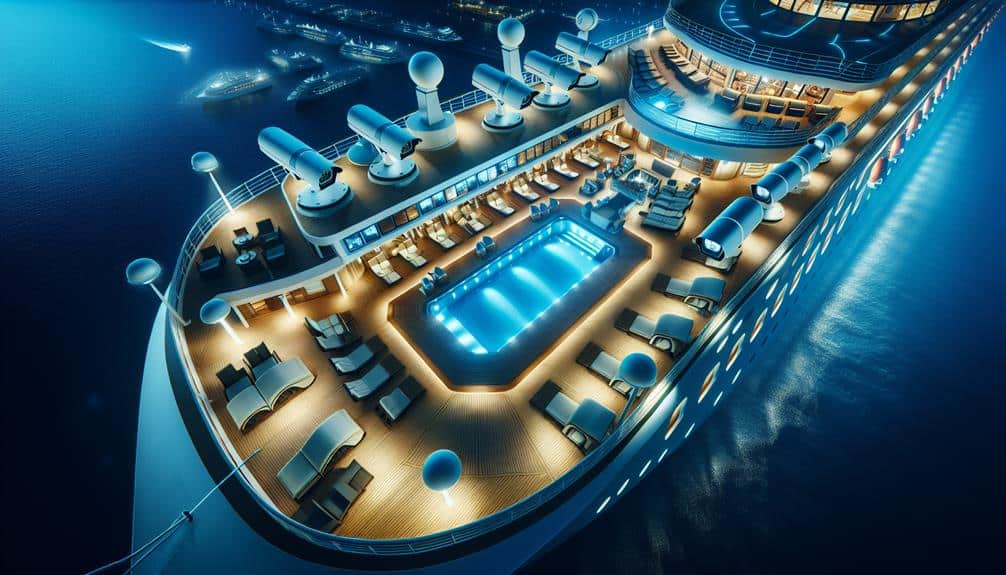Safeguard the safety of your cruise ship with advanced CCTV systems featuring high-resolution cameras for detailed monitoring and facial recognition technology for precise identification. Thermal imaging cameras offer enhanced intrusion detection and perimeter surveillance by capturing heat signatures and monitoring the ship's surroundings for potential threats. Implement access control solutions with biometric authentication and keyless entry systems to manage entry efficiently. Video analytics technology provides behavior and anomaly analysis in real-time, enhancing situational awareness. Integrated alarm systems offer rapid response with real-time alerts and advanced sensors for intrusion detection. Enhance security with these top surveillance systems for cruise ships.
Key Points
- High-resolution CCTV cameras for detailed monitoring.
- Thermal imaging cameras for enhanced intrusion detection.
- Access control solutions with biometric authentication.
- Video analytics technology for behavior and anomaly detection.
- Integrated alarm systems for real-time alerts and monitoring.
Advanced CCTV Systems
When implementing advanced CCTV systems for cruise ship security, prioritize high-resolution cameras with pan-tilt-zoom capabilities to enhance surveillance effectiveness. These cameras enable operators to remotely monitor different areas of the ship in real-time, providing a more thorough view of onboard activities.
Additionally, incorporating facial recognition technology into the CCTV systems can greatly improve security measures. Facial recognition allows for the quick identification of individuals, helping security personnel track suspicious persons or locate missing passengers efficiently.
Remote monitoring plays an important role in modern surveillance systems, allowing security teams to oversee multiple areas simultaneously from a centralized location. By integrating remote monitoring features into the CCTV setup, cruise ships can enhance their overall security posture and response capabilities.
Moreover, the ability to perform pan-tilt-zoom functions remotely provides operators with greater flexibility in adjusting camera angles and focusing on specific areas of interest swiftly. This level of control is essential in ensuring thorough surveillance coverage across the entire ship.
Thermal Imaging Cameras
To improve cruise ship security measures, consider incorporating thermal imaging cameras to strengthen surveillance capabilities. Thermal imaging cameras offer advanced features that are particularly useful for intrusion detection and perimeter surveillance on cruise ships. Here are three key points to keep in mind:
- Enhanced Intrusion Detection:
Thermal imaging cameras can detect intruders in complete darkness or challenging weather conditions by capturing the heat signatures of individuals, making them a valuable tool for identifying unauthorized individuals attempting to access restricted areas of the ship.
- Effective Perimeter Surveillance:
By providing clear images of the ship's surroundings, thermal imaging cameras can help security personnel monitor the ship's perimeter to identify any suspicious activity or potential threats in real-time, thus improving overall security on board.
- Integrated Surveillance Systems:
Integrating thermal imaging cameras with other surveillance systems, such as CCTV cameras and access control solutions, can create a comprehensive security network that guarantees all areas of the cruise ship are monitored effectively.
Access Control Solutions
Consider implementing access control solutions to strengthen the security infrastructure of cruise ships and regulate entry to sensitive areas effectively. Biometric authentication and keyless entry systems offer advanced methods to control access onboard.
Biometric authentication, such as fingerprint or facial recognition technology, guarantees that only authorized personnel can enter restricted zones, making it nearly impossible for unauthorized individuals to gain entry. This technology provides a high level of security as it's unique to each individual, reducing the risk of unauthorized access.
Keyless entry systems, on the other hand, offer convenience and efficiency while maintaining security. By using electronic keys or access cards, cruise ship staff can easily access different areas based on their clearance level. These systems also allow for quick deactivation of lost or stolen cards, enhancing overall security measures.
Implementing both biometric authentication and keyless entry systems can greatly enhance the access control measures on cruise ships, providing a secure environment for both passengers and crew.
Video Analytics Technology
Enhancing the security infrastructure of cruise ships can be further optimized through the integration of advanced Video Analytics Technology, offering thorough monitoring and threat detection capabilities throughout the vessel. Video Analytics Technology employs sophisticated algorithms to analyze video feeds in real-time, providing cruise ship security personnel with enhanced situational awareness and proactive threat identification.
Here are three key aspects of Video Analytics Technology that can revolutionize cruise ship security:
- Behavior Analysis: This technology can detect abnormal or suspicious behaviors, such as loitering in restricted areas or erratic movements, enabling security teams to respond promptly to potential threats.
- Facial Recognition: By utilizing facial recognition capabilities, Video Analytics Technology can identify individuals on watchlists or track the movements of specific persons of interest throughout the ship.
- Anomaly Detection: Video Analytics can automatically flag unusual activities, such as unauthorized access to sensitive areas or objects left unattended, helping security teams prevent security breaches before they escalate.
Implementing Video Analytics Technology on cruise ships can greatly enhance security measures and uphold a safe environment for passengers and crew.
Integrated Alarm Systems
Integrated Alarm Systems play a pivotal role in the all-encompassing security framework of cruise ships, providing real-time alerts and ensuring rapid response to potential threats. These systems are designed to seamlessly integrate with other surveillance components, enhancing the overall security posture of the vessel. Remote monitoring capabilities allow security personnel to access alarm notifications from any location, enabling swift decision-making and response coordination.
Intrusion detection is a key feature of integrated alarm systems on cruise ships. Advanced sensors and detectors are strategically placed throughout the ship to detect unauthorized access to restricted areas or unusual activity. When an intrusion is detected, the alarm system immediately alerts security personnel, allowing them to investigate the situation promptly.
The integration of alarm systems with video surveillance technology further enhances security measures by providing visual verification of alarms. This integration enables security teams to assess the situation accurately and respond effectively. By combining remote monitoring capabilities with intrusion detection features, integrated alarm systems contribute significantly to the safety and security of passengers and crew onboard cruise ships.
Frequently Asked Questions
How Do Cruise Ship Surveillance Systems Handle Privacy Concerns for Passengers?
Navigate the delicate balance of privacy protection on cruise ships with robust surveillance systems. Safeguard passenger data through encryption measures, ensuring security without compromising personal privacy. Trust in the technology to uphold confidentiality.
Can Cruise Ship Surveillance Systems Be Easily Integrated With Other Security Systems Onboard?
Integrating cruise ship surveillance systems with other security measures can pose challenges. Ensuring system compatibility is essential for seamless operation. Addressing integration issues early on and utilizing compatible technologies can enhance overall security effectiveness.
Are There Specific Regulations or Guidelines in Place for the Use of Surveillance Systems on Cruise Ships?
You must prioritize data protection and compliance when implementing surveillance systems on cruise ships. Regulations exist to guarantee proper use of these systems. Remote monitoring enhances security, aiding in efficient emergency response during critical situations.
How Do Cruise Ship Surveillance Systems Handle Monitoring in Areas With Limited Lighting or Visibility?
In areas with limited lighting or visibility, cruise ship surveillance systems utilize infrared technology for low light monitoring. These systems can overcome visibility challenges by capturing clear images in darkness, ensuring all-encompassing security coverage.
To safeguard the surveillance system's data and footage on a cruise ship, robust measures like data encryption and access control are in place. These safeguards guarantee unauthorized access is prevented, securing sensitive information effectively.




